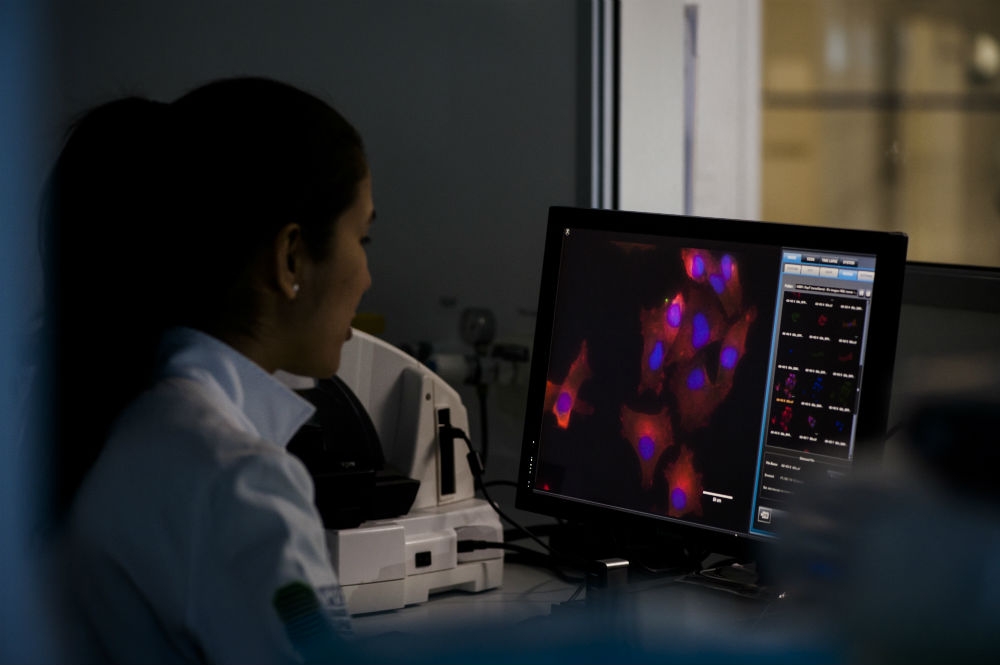


During a lecture at FAPESP Week France, Brazilian researcher who created a tool capable of automating parasite detection in stool analyses stressed that including experts from various areas in machine learning projects is essential for increasing the precision of results (photo: Léo Ramos Chaves, Pesquisa FAPESP)
Published on 05/04/2021
By Maria Fernanda Ziegler, from Lyon | Agência FAPESP – Machines can be trained to classify images and thus identify tumors in CT scans, mineral compositions in rocks, or pathologies in optical microscopy analyses. This artificial intelligence technique is known as machine learning and has gained new applications in recent years.
Machine training is carried out via the repetition of images used as examples of a particular context or situation and the adequate preparation of that material requires the effort of experts from a variety of areas.
“The human coordinates. Without the specialist controlling the training process, the machine can learn to make decisions based on characteristics of the image that are not related to the target problem. This generates a poor result or one restricted to the database in which the machine was trained. When the database changes, errors increase considerably, making the machine analysis unreliable,” said Alexandre Xavier Falcão, of the Institute of Computing of the University of Campinas (UNICAMP) in São Paulo State, Brazil, in a lecture given last Thursday (11/21) at FAPESP Week France.
Falcão has been combining computing science with different areas of knowledge based on machine learning projects, developed with FAPESP’s support, in a research line that investigates human-machine interaction in decision making.
Automation of parasite detection
One of the projects led by Falcão and presented at FAPESP Week France aims to automate parasite detection in stool analyses. The research was conducted via a partnership between Immunocamp (a Campinas-based company specialized in hospital products) and researchers from the Institutes of Computing and Chemistry of UNICAMP, as well as the School of Medical Sciences of the same university.
The interdisciplinary team has developed a machine – patented and soon available in the market – capable of identifying the 15 most prevalent species of parasites that infect humans in Brazil.
The machine learning technique showed more than 90% efficiency, which is much higher than the conventional analyses carried out by humans through visual analysis of optical microscopy slides, whose rates vary from 48% to, at most, 76%. The machine is also capable of processing 2,000 images in four minutes.
“The idea is not to substitute the work of humans, not least because they need to train the machines to identify more parasite species and confirm the diagnosis of pathogens detected by the machine, but rather to avoid human fatigue and increase the precision of the results,” he said.
The groundbreaking technology was also supported by FAPESP through the Innovative Research in Small Business Program (PIPE).
Interactive machine learning
One of the innovations created by the team from UNICAMP was a system for separating parasites and impurities based on the principle of dissolved air flotation, which enables optical microscopy slides with fewer impurities to be generated.
In the data science part, the machine is able to carry out an automated scan of the slide and detect parasites that appear in images on the computer screen. This was possible using computational techniques that separate the image components to verify and decide if they are related either to impurities or to one of the 15 parasitic species.
“The human-machine interaction has the potential to reduce human effort and increase confidence in the algorithmic decision. Our approach has shown that including the specialist in the training cycle generates reliable decision-making systems based on image analysis.”
Reliable decision-making systems
The aim of the methodology is to minimize the effort made by the specialist in terms of large-scale image observation, seeking the construction of highly accurate decision-making systems.
“The classical approach, which uses pre-recorded examples and no human interaction during training, leaves various questions unanswered. They are essential questions, such as how many examples are needed for the machines to learn or how to explain the decisions made by the machine. Our methodology consists of including the specialist in the machine learning cycle so that questions such as these are answered,” he said.
Therefore, the strategy used by Falcão’s team for building reliable decision-making systems has been to explore complementary abilities. “Humans are superior in knowledge abstraction. Machines do not tire and are better at processing large quantities of data. So, the specialist’s effort is minimized by controlling the learning cycle and the machines’ decisions become explainable,” he said.
The FAPESP Week France symposium took place between November 21st and 27th, thanks to a partnership between FAPESP and the Universities of Lyon and Paris, both in France. Read other news about the event at: www.fapesp.br/week2019/france/.
Source: https://agencia.fapesp.br/31991